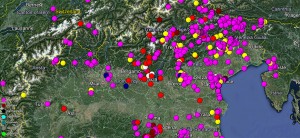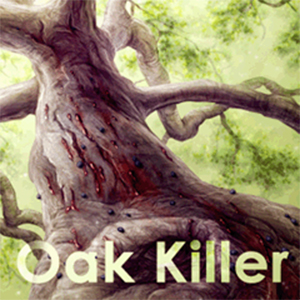Survival of P. ramorum (SOD pathogen) in wood chips depends on a few factors:
- Were the chips allowed to become wet?
- What size are the chips?
- Is green waste present?
- What time of year was the wood chipped?
- Where in California are the chips located?
Chips that are piled wet or tarped and include infected green waste (e.g. bay laurel leaves) may support pathogen viability for over 1 year, especially in mild coastal areas. If the wood is chipped in the summer and early fall and the chips are not piled, but rather broadcast in a 1-inch layer in a dry and sun-exposed area, pathogen viability may only be supported for a few weeks, especially if in hotter interior areas.
Survival of P. ramorum (SOD pathogen) in dead hosts or non-plant substrates is extremely variable and strongly affected by climatic factors. Although a comprehensive study on this topic has not conducted, extrapolating from several studies we can say the following:
Soil becomes more infectious from late winter to early summer in the presence of rainfall, so any movement of soil away from a SOD-infested area from January to July could transport viable P. ramorum.
Keep the following in mind:
- The larger the volume of soil moved, the greater the risk.
- In organic rich soils (e.g. top layers of forest soils), pathogen survival is less than 18 months.
- If P. ramorum is present in green waste incorporated in the soil, survival can be much longer (2 years or more).
- In inert soils (e.g. potting mix), the pathogen can survive multiple years. However, for all soils, areas with less temperate climates (cold winters, hot summers) may hasten loss of pathogen viability.
From a practical perspective, if infested forest soil is picked up on tires or shoes from late winter to early summer, the pathogen will likely remain viable for about 1 year, in the absence of incorporated green waste. If soil is picked up from late summer to early fall, survival duration is much less, possibly in the order of a few months.
SOD Blitzes include a training session for blitz volunteers on SOD and proper sampling, followed by time in the field for collecting and marking sample locations. All necessary collection materials are provided to volunteers during the training session for use either the same day of the training or the day after. All samples are to be dropped off at a designated location (location announced at the training session). There are approximately 20 SOD Blitzes in areas of California that have sudden oak death or at risk of disease establishment. Most of the training sessions are offered on Saturday mornings. SOD Blitz schedules for the coming year are posted annually during the last week of January at www.sodblitz.org.
Injections may be better for large trees with a regular shape, while topical applications may be better for large, irregular, gnarly trees.
In order to obtain maximum efficacy with oak phosphonate treatments, minimum temperatures should not be below 50 ºF. Maximum daytime temperatures should be higher than 60 ºF, but not exceed 85 ºF.
Based on the study published by the UC Berkeley Garbelotto lab in California Agriculture (http://nature.berkeley.edu/garbelotto/downloads/calag2009.pdf), azomite and/or lime washes alone are not effective in controlling SOD.
While phosphonate injections to help control SOD are now recommended once every 2 years, spray applications should still be applied to the bark of oak trees annually.
The stems of poison oak plants can be infected by Phytophthora ramorum (the plant pathogen known to cause SOD); however, we do not know if leaves can be.
The stems of poison oak plants can be infected by Phytophthora ramorum (the plant pathogen known to cause SOD); however, we do not know if leaves can be.
If SOD phosphite treatments are being applied by injection November 1st – December 15th, data has shown that treating every 2 years is sufficient. When preparing the injections, be sure to use the most current dosage recommendations as they have recently been updated. Current recommendations can be found at http://nature.berkeley.edu/garbelottowp/?page_id=2345. The new dosages are significantly more diluted than the original label dosages, yet are just as effective and cause almost no damage to the wood (the original label dosages do cause some wood damage).
If SOD phosphite treatments are being applied using a topical bark application, treat every 1 – 2 years. While data has shown that topical applications last for 18 months, fall treatments are the most effective. Therefore, in a county known to be infested, treat trees in riparian areas, within 20 miles of the coast, or within 2 miles of redwood forests every year. Treat trees in drier areas (of infested counties) every 2 years.







